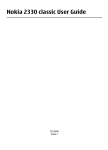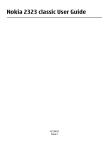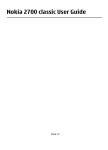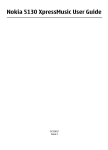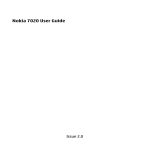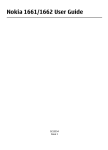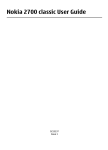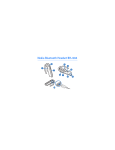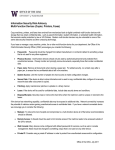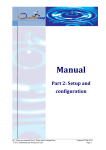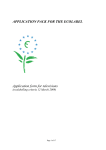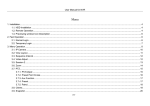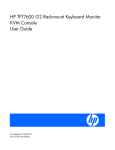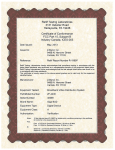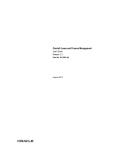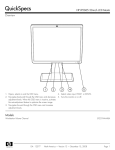Download HP Green Procurement Guidance
Transcript
May 2008 White Paper HP Green Procurement Guidance Introduction......................................................................................................................................... 2 Product 1. 2. 3. Attributes................................................................................................................................. 3 Servers, PCs (Desktop & Notebooks) and Monitors....................................................................... 3 Imaging & Printing Devices ....................................................................................................... 4 Printing Supplies ...................................................................................................................... 5 Generic Attributes ................................................................................................................................ 7 4. Packaging............................................................................................................................... 7 5. End-of-Use Services .................................................................................................................. 7 6. Supply Chain Responsibility .................................................................................................... 10 7. Organization’s Performance.................................................................................................... 10 Environmental standards, self-declarations and eco-labels....................................................................... 11 8. Environmental standards and labels ......................................................................................... 11 9. Self-declaration vs. eco-labels .................................................................................................. 12 10. Electronic Industry Code of Conduct (EICC) ............................................................................... 13 Appendix – Sample Questionnaire ...................................................................................................... 14 Product Attributes ........................................................................................................................... 14 Generic Attributes .......................................................................................................................... 16 Social & Environmental Responsibility Attributes................................................................................. 17 Introduction The purpose of this White Paper is to examine some general principles applicable to the development of environmental procurement criteria. The context of discussion is specifically related to Information Technology (IT) products and services. There are some broad principles that HP recommends organizations developing environmental procurement criteria to recognize. These principles ensure that the procurement guidelines are useful to procuring organizations as well as being fair, understandable and environmentally and economically viable for suppliers. We recommend that procurement guidance to be based on the following principles: Fairness and equitability – Any procurement criteria that are developed should aim to be fair and equitable and take into consideration environmental aspects throughout the life cycles of different product options. Green procurement should not be viewed as a vehicle to favour certain goods and/or services. The procurement criteria shall ensure fair treatment for all suppliers.1 Harmonization and recognition of international standards – There are numerous environmental standards in the global marketplace. HP supports the general harmonization of the various standards and procurement schemes, particularly in relation to criteria and tool development as well as testing methodologies. Prioritization – The nature of the procuring organization, and the type and quantity of products purchased determine the environmental impact associated with the procurement activity. For the criteria to deliver benefit, it should be derived from the overall environmental priorities of the procuring organization. It is important for any organization drafting procurement criteria to prioritize the green procurement specifications based on good science that focuses on issues that warrant attention, i.e. to address areas of greatest risk for the procuring organization. Procurement criteria, that cite a maximum number of requirements that are rated with the same importance, may run the risk of rejecting many environmentally viable products that would otherwise meet or exceed the majority of the criteria, but fail on a single, and perhaps, minor point of assessment. Measurability / verifiability – Environmental criteria should only be used if they are measurable (i.e. refer to an existing standards), comparable (i.e. allow comparison between competing products) and verifiable by the purchaser. There are a number of methods for verification; these include confirmation from the supplier, selfdeclaration, second or a third party declaration etc. HP supports programs where producers “self-declare” their conformance with published standards. Many standards already operate effectively on a system of selfcertification, where producers document their conformance through submittals or record keeping (e.g. US EPA Energy Star, Germany’s Blue Angel). A trail of auditable documents ensures that conformance can be enforced. Appropriate weighting should be assigned to the environmental section in the tender. The weighting should reflect the procuring organizations’ priorities and as such is likely to differ from one procuring organizations to another. Advising suppliers on the weighting is recommended as this will help the suppliers to assess and improve their environmental performance. Process transparency – To ensure that the environmental procurement program has realistic goals and expectations it is recommended for the procuring organization to engage in dialog with the suppliers and other interested stakeholders. Transparent processes and discussion with stakeholders will provide the procuring organization with a clearer picture of what is happening in the market place and should aid in assessing the impact, measurability and options associated with specific environmental performance criteria. The following sections outline some of the most commonly used sustainable procurement criteria for IT products and HP’s recommendations for specifying the criteria that comply with the principles summarized in this introduction 1 Some organizations in the public sector may have internal constraints as to how these principles can be applied under the laws implemented and in force. Product Attributes The regulatory or voluntary requirements affecting IT and their suppliers today cover a wide array of topics including environmental management systems, product energy consumption, Design for Environment (DfE), and material content as well as end-of-use treatment requirements for products and packaging. We recommend referring to these existing requirements / standards. This will help the procuring organizations to further define “best practice” and enable an “apples-to-apples” comparison that supports an informed choice. In addition, they are commonly recognized by the electronics industry and internationally agreed testing, reporting and verification processes exist. 1. Servers, PCs (Desktop & Notebooks) and Monitors 1.1. Energy Currently the recognized benchmark for energy-efficient PC equipment is ENERGY STAR®. While ENERGY STAR® is a program of the US Environmental Protection Agency (EPA) has been adopted by many countries around the world and has global impact. 1.1.1. Monitors (Display Devices): HP recommends that Flat Panel displays be specified as they are more energy efficient and use less material vs. CRT monitors. The display device shall be qualified per ENERGY STAR® standard. 1.1.2. Desktop and Notebook Personal Computers shall be qualified per ENERGY STAR® standards and conform to the most current criteria at the time. 1.1.3. External Power Supply (EPS): External power supplies shall conform to the most stringent regulation existing at the time, which is at the time of publication of this White Paper, the California Energy Commission standard for external power supplies. 1.1.4. For Servers there is currently no generally agreed standard, such as ENERGY STAR®. HP is preparing recommendations based on developing international standards. 1.2. Emissions During normal operation PC and monitors are not expected to emit chemicals or VOC (volatile organic compounds); therefore an emission criterion for PCs and monitors is not required or necessary. 1.3. Acoustics The supplier shall disclose sound power data measured and declared according to ISO7779 and ISO 9296. 1.3.1. Products with no moving parts shall be exempt from this criterion by stating the device does not have any moving parts. 1.4. Materials Materials used to manufacture a product are significant in that these materials impact the “environmental footprint”, ensure a safe and reliable product, and affect the product ease of recycling when disposed at the end of its useful life. HP recommends a specification that requires the supplier to provide information about their supply chain standards and supplier management processes that aim to prevent the inclusion of regulated and restricted materials in their products. An example of such a standard is the HP General Specification on the Environment. The latest version can be found at http://www.hp.com/hpinfo/globalcitizenship/environment/pdf/gse.pdf 1.4.1. The supplier provides products that meet material restriction requirements, e.g. EU RoHS Directive on the “Restriction of the use of certain Hazardous Substances in Electrical and Electronic Equipment” (2002/95/EC). 1.4.2. All batteries used in the product shall conform to the EU Directive on batteries and accumulators (2006/66/EC). 1.5. Design for Environment (DfE) Effective “Design for Environment” programs typically focus on energy efficiency, design for reuse and ease of recycling, packaging and materials innovation. Such DfE features can provide value to the user by possibly extending the useful life of a product, allow for easy upgradeability and for responsible recycling at the end of a products’ useful life, amongst other things. 1.5.1. All molded plastic parts greater than 25 grams shall be marked according to ISO 11469 and ISO 1043 parts 1-4. 1.5.2. If post-consumer recycled plastic content is included in the manufacture of the product it should be measured as a total percentage of recycled plastic content as a percent of total plastics. 1.5.3. The product should allow for ease of upgradeability thus extending the product life. 1.5.4. Spare Parts shall be available for a minimum number of years after purchase, e.g. five years. 2. Imaging & Printing Devices 2.1. Energy Currently the recognized benchmark for energy-efficient imaging and printing equipment is ENERGY STAR®. While ENERGY STAR® is a program of the US Environmental Protection Agency (EPA) has been adopted by many countries around the world and has global impact. 2.1.1. ENERGY STAR® standards currently exist for ink and laser printers, multi-function devices, copiers, fax and scanners. 2.1.2. External Power Supply (EPS): External power supplies shall conform to the most stringent regulation existing at the time, which is at the time of publication of this White Paper, the California Energy Commission standard for external power supplies. 2.2. Chemical Emission 2.2.1. All chemical emission data should be measured for the printing system (printer & supplies) and reported in accordance with ECMA-328. 2.2.2. Supplier should provide products that are certified per the Blue Angel program in Germany in accordance with RAL-UZ 85/114 or RAL-UZ 122. 2.3. Acoustics The supplier shall disclose sound power data measured and declared according to ISO7779 and ISO 9296. 2.3.1. Products with no moving parts shall be exempt from this criterion by stating the device does not have any moving parts. 2.4. Materials 2.4.1. The supplier shall provide information about their supply chain standards and supplier management processes that aim to prevent the inclusion of regulated materials and materials of concern in their products. An example of such a standard is the HP General Specification on the Environment. The latest version can be found at http://www.hp.com/hpinfo/globalcitizenship/environment/pdf/gse.pdf 2.4.1.1. The supplier provides products that meet material restriction requirements, e.g. EU RoHS Directive on the “Restriction of the use of certain Hazardous Substances in Electrical and Electronic Equipment” (2002/95/EC). 2.4.1.2. All molded plastic parts > 25 grams should be marked with material codes according to ISO 11469. 2.4.2. Post-consumer recycled plastic content shall be included in the manufacture of the product and is measured as a total percentage of recycled plastic content as a percent of total plastics. 3. Printing Supplies 3.1. Emissions See printer emission above. The supplies being purchased should have been tested in the printer in which they would be used. 3.2. Materials 3.2.1. The ink/toner formulation/preparation and newly manufactured parts do not contain substances above the following threshold concentrations: Cadmium: Chromium VI: Lead: Mercury: PBB’s and PBDE’s: 100ppm 1000ppm 1000ppm 1000ppm 1000ppm The ink/toner formulation/preparation does not contain Azo colorants that split aromatic amines as specified in EU Directives 2002/61/EC, 2003/3/EC and as amended. For cartridges for Electro photographic (EP) systems: The photoconductor drum contains less by weight of the following substances: Cadmium: Selenium: 100ppm 1000ppm The ink/toner formulation/preparation contains less than 1% by weight of short-chain chlorinated paraffin’s according to EU Directive relating to restrictions on the marketing and use of certain dangerous substances and preparations (2002/45/EC) and as amended. Print Supply plastic housing/external parts greater than 25g contain less than 0.1% by weight of the following substances: chlorine, bromine. 3.2.2. All plastic parts, heavier than 25g have material identification marking according to ISO11469. Print Supply is designed to meet the “Recyclable Design of Consumables” requirements as specified in Blue Angel program in Germany (according to RAL-UZ 85/114 or RAL-UZ 122). 3.2.3. Both the retail packaging and the print cartridge are clearly labeled with the name of the entity placing the product on the market. Generic Attributes 4. Packaging 4.1. Material Content Ozone Depleting Substances in Packaging Materials: Chlorofluorocarbons (CFCs) and Hydrochlorofluorocarbons (HCFCs) must not be used in plastic foam packaging materials; for example, as foaming agents. Methyl bromide sterilization must not be used on wood packaging. Heavy Metals in Packaging Materials: Packaging materials must not contain lead, mercury, cadmium, or hexavalent chromium where the sum concentration of incidental lead, mercury, cadmium, and hexavalent chromium is greater than 0.01% (100ppm) by weight. Recycled content of packaging materials should be the highest percentage available in the market where the packaging is produced. Care should be taken by the package designer to insure that product protection is not compromised by packaging recycled content. PVC should not be used as a packaging material or at a minimum be in the process of elimination based on a firm plan. 4.2. Recyclability Material selection is made based on factors such as recyclability which varies region to region and the impact on the size and weight of the packaged product which in turn impacts the CO2 footprint of transportation. Use of permanent adhesive to affix dissimilar materials together must be avoided as this practice will cause issues in material separation for recycling. For materials used in packaging, the applicable recycling coding is required to be embossed or marked on all packaging components. The symbol, not including the lettering, must be between 1.27 cm (0.5 in) and 2.54 cm (1 in) in height. Smaller symbols are permitted when the part size does not allow the above minimum sizes requirements to be met. Parts that are too small to allow a readable symbol are exempt. The symbol and the lettering must be printed, molded or embossed into the base of a component or labeled. It must be durable, clearly visible, and easily legible when the packaging is opened. The abbreviations must appear in capital letters. 5. End-of-Use Services When IT equipment no longer meets an organization’s requirements and needs to be replaced, they often face a challenge. By thinking ahead, organizations can minimize or eliminate risks associated with the disposition of IT equipment and maximize upside possibilities. Equipment not suitable for reuse or resale should be dismantled and recycled in accordance with applicable environmental standards. Whoever provides this service should accept the responsibility for the equipment and recycling processes and specify how and where the equipment will be processed and what will be done with the recovered materials. The supplier should maintain the highest standards for risk mitigation and environmental protection. Following end-of-use services shall be taken into consideration: 5.1. Recycling Electronic equipment often contains heavy metals and other hazardous substances, and should be refurbished or recycled properly. To assess a recycling service provider, there are a number of issues that need to be considered, e.g. the length the service provider has been recycling products and offers consistent recycling on a regional or global level. A supplier managing their own vendors should ensure that the vendor providing the recycling service has established 1) recycling standards and 2) is auditing / qualifying / measuring recyclers against these standards to assure they are met and how they are met. It is also important to understand the overall technological experience and knowledge a supplier and recycling vendor has, and if there are any serious recycling violations that are in legal mitigation. Finally, a supplier should be able to provide certificates of destruction if requested. 5.2. Reuse Extending the life of IT equipment, reducing environmental impacts and making products accessible to more people through hardware repair and refurbishment programs should be a priority. Several aspects shall be taken into account when assessing reuse capabilities. A few examples include the redeployment of “end-of-use” equipment to be considered within the organization, or if the reuse supplier accepts used equipment in part for trade or replacement equipment, or even offer a monetary rebate. Many organizations contribute the value of their surplus equipment to a nonprofit organization as a possible charitable donation. If partnering with a supplier or service provider is considered, there should be processes in place for the equipment to be tested and evaluated, refurbished, and if applicable, loaded with new software before marketed. The service provider shall have specialized skills that encompass secondary market knowledge and data privacy standards. In order to maintain high quality standards, for printing supplies it is important to understand if the supplier does not choose to reuse print cartridges. Last but not least, the service provider shall be able to remarket all types of equipment no matter who manufactured it originally. 5.3. Leasing When equipment is leased asset disposal or recovery usually becomes the responsibility of the lessor. Following are environmental concerns related to leasing that should be considered, e.g. the lessor may offer management of all IT equipment and not just what is obtained from a new purchase. At the end of the lease term, the equipment could simply be returned to the lessor company. If returned, they shall accept and mange disposition responsibly in accordance with applicable environmental laws. Inquire if the lessor posses its own disposition capabilities and maintains strict business and process controls, or is everything outsourced. Critical can be how the lessor manages returned equipment and assures that the chain of custody is tightly controlled and handled in accordance with applicable environmental regulations. Check if the lessor arranges for all logistics including data privacy assurance and can offer equipment return options for obsolete, end-of-use, or scrap that is not leased, for example: 5.3.1. if the leasing company offers revenue sharing for resold assets, or 5.3.2. offer cash for unwanted equipment, and 5.3.3. offer proof of destruction documents that include serial numbers of equipment that has been scrapped. 5.4. Data Security Computers, servers, cell phones, personal digital assistants and other intelligent devices are more than business tools; they’re libraries filled with perhaps sensitive information about the organization, employees, customers, etc.. 5.4.1. Secure disposition of retired equipment requires chain of custody and control as the hardware is inventoried, stored, shipped and evaluated for resale or disposition. Physical storage must be destroyed or thoroughly erased (wiped) to ensure information stays out of the wrong hands. 5.4.2. The service provider should offer flexible data erasure options that are compliant with the DoD 5220.22-M recommendations (or equivalent) for both PC and server technology with validated processes. Non-functional drives should be physically destroyed and that this process too, is validated. 6. Supply Chain Responsibility There are several factors that should be considered in selecting a socially and environmentally responsible vendor for purchasing electronic equipment. An organization’s strength and experience in social and environmental responsibility and the way they manage their suppliers can be compared against other companies by asking for information about an organization’s commitment, activities/implementation, and how they demonstrate and report results. 6.1. Code of Conduct The procuring organization should verify that the supplier has rigorous supply chain standards and program in place for ensuring their suppliers have appropriate social and environmental practices: • policies, • contract clauses, • implementation tools, • conformance monitoring/onsite audits, • corrective actions, and • results reporting. 6.2. Standards Suppliers may be asked to self-declare the relevant processes, provide demonstrable results, and to refer to any existing supply chain codes they require their suppliers to meet. The Electronics Industry Code of Conduct (EICC) is an example of an industry-wide supplier code that is widely recognized and adopted by office equipment suppliers. 6.3. Supply Chain Data With complex global supply chains, it can be virtually impossible for the procuring organization to ascertain and verify the manufacturing practices utilized throughout the entire product supply chain in all locations at any given time. Suppliers should not be asked to meet overly burdensome administrative requests for data that cannot be easily compared to other suppliers and is considered confidential due to contractual requirements with their own suppliers (e.g. audit reports of individual suppliers). 7. Organization’s Performance 7.1. Environmental Policy Suppliers shall have a written corporate environmental policy in place consistent with all aspects of the requirements laid out in the environmental policy section of ISO 14001. 7.2. Environmental Management System (EMS) Suppliers shall have a self-certified, operational EMS that meets the requirements of ISO 14001 or equivalent internationally accepted environmental management system. 7.3. Reporting Suppliers shall publish an annual report that meets the reporting requirements of ISO 14001 or equivalent internationally accepted reporting standards, like the U.S. EPA National Environmental Performance Track program or the GRI Sustainability Reporting Guidelines. Environmental standards, self-declarations and eco-labels 8. Environmental standards and labels Over the past two decades many standards and eco-labels have been developed in response to the increasing demand for information on the environmental attributes of products. Today there are a number of regional and national labeling programs in place which may differ in its scope and application. HP, together with other suppliers is actively involved in efforts to encourage and drive global harmonization and acceptance of environmental criteria. The following schemes do not represent a complete list of available programs, but are chosen to demonstrate a selection of internationally recognized environmental standards and labels HP recommends. 8.1. ENERGY STAR® ENERGY STAR is a United States government program to promote energy efficient products. It is well known for its logo appearing on many computer products and peripherals. More Information can be found at: • • http://www.energystar.gov/index.cfm?fuseaction=find_a_product.showProductCategory&pcw_c ode=OEF for general information about ENERGY STAR and office equipment, or http://www.energystar.gov/index.cfm?c=product_specs.pt_product_specs#off for office equipment product specification. 8.2. IEEE 1680 “EPEAT™” EPEAT™, short for Electronic Product Environmental Assessment Tool is a system to help purchasers in the public and private sectors evaluate, compare and select desktop computers, notebooks and monitors based on their environmental attributes. There are 51 total environmental criteria in IEEE 1680; 23 required criteria and 28 optional criteria. More Information can be found at: • http://www.hp.com/sbso/solutions/pc_expertise/energy-efficientcomputing/epeat.html?jumpid=reg_R1002_USEN, or • http://www.epeat.net/, the official EPEAT website with product registry. 8.3. ECMA-370 (IT Eco Declaration) IT Eco Declarations provide environmental information for a specific product or product family in an industry standard format developed by IT organizations in Sweden, Norway and Demark. IT Eco Declarations may be used for any IT product category. For personal computers and workstations, these are for the CPU only and do not include the monitor. More Information can be found at: www.hp.com/hpinfo/globalcitizenship/environment/productdata/index.html 8.4. Blue Angel (RAL UZ 122 for Printers & Copiers), (RAL-UZ 78 for Computers). The German Blue Angel scheme is one of the oldest environment-related labels in the world for products and services and is well known in many countries, particularly in Europe. More Information at: http://www.blauer-engel.de/englisch/navigation/body_blauer_engel.htm 8.5. TCO The Swedish TCO eco-label has criteria for IT products like displays, printers and personal computers (most commonly associated with computer monitors) and are named after years. The latest version for monitors is TCO ’05 (for 2005). More information about other eco-labels and HP products can be found at: http://www.hp.com/hpinfo/globalcitizenship/environment/productdesign/ecolabels.html?jumpid=reg_R1002 _USEN 9. Self-declaration vs. eco-labels Environmental design of products and packaging is often addressed through voluntary eco-labels such as Blue Angel, Taiwan Green Mark, New Zealand Environment Choice and many more. Eco-labels are often seen as an easy way to identify “green” products. Whilst eco-labels may be used as an indication, there are some shortfalls of eco-labeling schemes in existence today. Many of the eco-label criteria do not fulfill the general principles outlined in this document. It is common for eco-labels to include a maximum number of possible environmental criteria, rather than prioritizing those aspects that warrant attention. This leads to technical and practical issues within the scheme and makes it difficult for the schemes to handle the number and the variety of products on the marketplace. For example a supplier of PCs who wants to apply for a specific eco-label, has to meet all the criteria of that scheme. The label is only warranted when every single criterion are fulfilled. For suppliers with large product portfolios who like to have all their products labeled with such an eco-label, an outside verification body would have to take into consideration thousands of steps of analysis for only one company and only in the country or region the labels applies to. There are numerous environmental labeling schemes/procurement standards in the global marketplace for IT products. Many of these schemes presently have different environmental criteria and measurement methodologies. This means that, in order to obtain certifications for the different eco-labels around the world, global suppliers applying for such labels would have to duplicate the testing process several times in order to meet the criteria for the differing national and regional requirements. A situation where a particular product achieves an eco-label certification in one country, but may not in another, creates market confusion and questions the validity of the criteria and test methodologies between the different schemes. It also runs a risk of creating barriers in the marketplace through artificial product procurement preference without fair, meaningful and comparable testing methods and results. All those issues typically lead to added cost not only for the supplier, but also to the procuring organization with no commensurate benefit for the customer or the environment. Based on these issues with existing eco-labeling schemes, HP recommends the system of self-certification where suppliers self-declare compliance of their products against pre-defined and harmonized criteria. The main benefit of this system is to keep both the procurement and supply processes most efficient. One of the most comprehensive forms of self-declaration is the IT Eco-Declaration, that includes information on the environmental practices of the supplier as well as product features in areas, such as environmentally conscious design, batteries, acoustic noise, electrical safety, energy consumption, chemical emissions, substances and materials included, and packaging. The IT Eco-Declaration scheme makes it easy to compare different suppliers and their products, as they all present the environmental features of their products in the same way, through a common industry standard reporting form. The declaration has the advantage of being developed in accordance with international standards. It contains as many or more criteria than typical eco-label schemes. Given that the IT Eco-Declaration covers the most comprehensive set of criteria, HP recommends the IT Ecodeclarations to be used when prioritizing and setting threshold criteria for environmental procurement of IT products. The IT Eco-declaration scheme includes a third-party verification review to ensure the scheme’s integrity and provides procurers with the required level of assurance. Self-verification is a common practice even within the aforementioned eco-labeling schemes. Many of those schemes operate effectively on a system of self-declaration, where suppliers document their conformance through submittals or record keeping (e.g. Energy Star, EPEAT, Blue Angel, Japan Green Purchasing Law, etc.). A trail of auditable documents ensures that conformance can be ensured. If verification is deemed necessary to check these documents, such process should be conducted on a random basis, which keeps the cost manageable but still provides the required assurance. Discovery of non-conformance to self declared criteria could be subject to harsh penalties, and provides a clear incentive for accurate and true self-declaration. If a reference to an eco-label scheme is required as part of the supplier verification, HP recommends the requirements not be limited to one or only a few eco-labeling schemes, but rather verification through any recognized eco-label or self-verification scheme should be accepted. Referring to an eco-label developed by an individual country is not recommended as this practice may run the risk of creating barriers to free trade and competition. Should an eco-label scheme be considered as the means of eco-verification, we recommend that an eco-label list should be provided as guidance of the range and type of eco-labels in existence and not as a complete and exclusive list of labels deemed to be acceptable. 10. Electronic Industry Code of Conduct (EICC) The Electronic Industry Code of Conduct outlines standards to ensure that working conditions in the electronics industry supply chain are safe, that workers are treated with respect and dignity, and that manufacturing processes are environmentally responsible. The EICC has been adopted and implemented by some of the world’s major electronics brands and their suppliers. The goal is to improve conditions in the electronics supply chain. Development of the Code was a multi-stakeholder effort, influenced by internationally-recognized standards. More information is available at: www.eicc.info. Product Attributes 1. Materials 1.1 Does/Do the product/products comply with the EU RoHs Directive 2002/95/EC and its amendments? 1.2 Products do not contain Asbestos (76/769/EEC, amendment 1999/77/EC)? 1.3 Products do not contain Ozone Depleting Substances: Chlorofluorocarbons (CFC), hydrobromofluorocarbons (HBFC), hydrochlorofluorcarbons (HCFC), Halons, carbontetrachloride, 1,1,1-trichloroethane, methyl bromide? 1.4 Products do not contain polychlorinated biphenyl (PCB), polychlorinated terphenyl (PCT), (76/769/EEC)? 1.5 Products do not contain short chain chloroparaffins (SCCP) with 10-13 carbon atoms in the chain containing at least 48% per mass of chlorine in the SCCP as specified in Norwegian regulation relating to restrictions on the use of certain dangerous chemicals 20.12.2002? 1.6 Textile and leather parts with direct skin contact do not contain Tri-(2,3,-dibromopropyl)-phosphate (TRIS), Tris-(aziridinyl)-phosphineoxide (TEPA), polybrominated biphenyl (PBB) (76/769/EEC)? 1.7 Textile and leather parts with direct skin contact do not contain Azo colourants that split aromatic amines as specified in 76/769/EEC, amendment 2003/3/EC? 1.8 Wooden parts do not contain arsenic and chromium as a wood preservation treatment as well as pentachlorophenol and derivatives (76/769/EEC)? 1.9 Parts with direct and prolonged skin contact do not release nickel in concentrations higher than specified in 76/769/EEC, amendment 94/27/EEC? 2. Batteries 2.1 If hazardous batteries (as defined in 91/157/EEC) are used in the product they are easily removable and labeled with the disposal and the substance logo (as defined in 91/157/EEC, 93/68/EEC)? 2.2 If batteries are used in the product, they do not contain mercury in concentrations higher than specified in 91/157/EEC? 2.3 If batteries are permanently installed in the product, information on the environmentally hazardous substances and safe removal method is listed in the user manual (91/157/EEC)? 3. Electrical safety, EMC and connection to the telephone network 3.1 The product meets the Low Voltage Directive (LVD) regarding electrical safety in accordance with 2006/95/EC (former 73/23/EEC) and CE Marking in accordance with 93/68/EEC? 3.2 The product meets the EMC Directive regarding electromagnetic compatibility (89/336/EEC / 2004/108/EC? 3.3 If product is intended for connection to a public telecom network or contains a radio transmitter, it meets the EU Radio Equipment and Telecommunications Terminal Equipment Directive (1999/5/EC)? 3.4 The product is CE-marked and a Declaration of Conformity is available (93/68/EEC)? 4. Consumable materials 4.1 If a photo conductor (drum, belt etc.) is used in the product, it does not contain cadmium in concentrations higher than specified in EU Directive 76/769/EEC and 91/338/EEC? 4.2 If ink/toner is used in the product, it does not contain cadmium in concentrations higher than specified in EU Directive 76/769/EEC and 91/338/EEC? 4.3 If the ink/toner formulation/preparation is classified as hazardous according to EU Directive 99/45/EC, and as amended, the product/packaging is labeled and a Material Safety Data Sheet (MSDS) in accordance with EU Directive 99/45/EC and 2001/58/EC is available? 5. Product packaging 5.1 The sum of the concentration levels of lead, cadmium, mercury, and hexavalent chromium present in packaging or packaging components does not exceed 0,01% by weight (94/62/EC)? 5.2 Plastic packaging material is marked according to ISO 11469 referring ISO 1043 (97/129/EC)? 5.3 The product packaging material is free from CFC/HCFC? Y N N/A Y N N/A Y N N/A Y N N/A Y N N/A PCs & Displays Printing & Imaging Supplies Enterprise Servers Appendix – Sample Questionnaire 6. Treatment information (recycling/reuse/leasing) Y N N/A 6.1 Information for recyclers/treatment facilities (e.g. as required by 2002/96/EC) is available? 6.2 How long has the service provider been recycling products? No. of years: _______ 6.3 Where do they offer consistent recycling? (e.g. globally)? 6.4 Does the supplier manage their own vendors to assure high quality standards are met? If so, how? 6.5 Overall, how much experience (technological knowledge) does the supplier have? 6.6 Are there any serious recycling violations that are in legal mitigation? 6.7 Can the supplier provide certificates of destruction if requested? 6.8 Has been redeploying of “end-of-use” equipment been considered within the organization? 6.9 Can the reuse service partner accept used equipment in part for trade or replacement equipment, or offer a monetary rebate? 6.10 Many organizations contribute the value of their surplus equipment to a nonprofit organization as a charitable donation. Is this a possibility? 6.11 If partnering with a service provider is considered, are there processes in place for the equipment to be tested, evaluated and refurbished? 6.12. Does the service provider have specialized skills that encompass secondary market knowledge and data privacy concerns? 6.13 To maintain high quality standards, is the service provider choosing NOT to reuse print cartridges? 6.14 Can the service provider remarket all types of equipment no matter who manufactured it originally? 6.15 Can the lessor ensure management of all IT equipment, not just what is obtained from a new purchase? 6.16 At the end of the lease term, can the equipment simply be returned to the lessor company and do they clearly accept and mange disposition responsibly and in accordance with applicable environmental laws? 6.17 Does the lessor posses its own disposition capabilities and maintains strict business and process controls, whether processed internally or outsourced? 6.18 How does the lessor manage the returned equipment to assure the chain of custody is tightly controlled and handled in accordance with applicable environmental regulations? 6.19 Will the lessor arrange for all logistics including data privacy assurance? 6.20 Can the lessor offer equipment return options for obsolete, end-of-use, or scrap that is not leased? 7. Disassembly, Recycling, Product life, Material and Substances Y N N/A 7.1 Parts that have to be treated separately are easily separable? 7.2 Plastic materials in covers/housing have no surface coating? 7.3 Plastic parts >100g consist of one material or of easily separable materials? 7.4 Plastic parts >25g have material codes according to ISO 11469 referring ISO 1043? 7.5 Plastic parts are free from metal inlays or have inlays that can be removed with commonly available tools? 7.6 Labels are easily separable? (This requirement does not apply to safety/regulatory labels)? 7.7 Upgrading can be done e.g. with processor, memory, cards or drives? 7.8 Upgrading can be done using commonly available tools? 7.9 Spare parts are available after end of production for 5 years? 7.10 Service is available after end of production for 10 years? 7.11 Electrical cable insulation material of power cables are halogen free (including PVC)? 7.12 Electrical cable insulation material of signal cables are halogen free (including PVC)? 7.13 All cover/housing plastic parts >25g are halogen free? 7.14 All printed circuit boards (without components) >25g are halogen free? 7.15 Chemical specifications of flame retardants in cover / housing plastic parts >25g according ISO 1043-4? 7.16 Chemical specifications of flame retardants in printed circuit boards (without components) >25g according ISO 1043-4? 7.17 Plastic parts >25g are free from flame retardant substances/preparations above 0.1% classified as R45/46, R50/51/53 and R60/61 (67/548/EEC) 7.18 Light sources are free from mercury? If mercury is used: Number of lamps: and max. mercury content per lamp: mg 8. Batteries Y N N/A 8.1 Product does not contain batteries defined as hazardous according to 91/157/EEC 8.2 Battery chemical composition: ___________________________________ 8.3 Batteries meet the requirements of the following voluntary program/s: ____________________________ 9. Energy consumption Y N N/A 9.1 The product meets the energy requirements ENERGY STAR® or others specify: _____________________ 10. Emissions Y N N/A 10.1 The product meets the acoustic noise requirements in accordance with ISO 9296? 10.2 The product meets the chemical emission requirements in accordance with e.g. ECMA-328? 11. Consumable materials for printing products 11.1 A Material Safety Data Sheet (MSDS) is available for the ink/toner preparation? 11.2 Paper containing recycled fibers that meets the requirements of EN12281 can be used? 11.3 Two-sided (duplex) printing/copying is an integrated product function? 12. Packaging and documentation 12.1 Product packaging material type(s): _____________________________ weight (kg): ___________ 12.2 Product plastic packaging is halogen free (including PVC)? 12.3 User and product documentation do not contain chlorine bleached paper? 12.4 User and product documentation contain recycled paper? Y N N/A Y N N/A Generic Attributes 1. Organization Information 1.1 Does the organization have a documented environmental policy approved by the management? 1.2 Does the organization have an environmental management system covering Product Development and/or ISO 14001 EMAS Other (explain)? Manufacturing? If so, is it certified according to: 1.3 Does the organization regularly publish an environmental report? The Global Reporting Initiative (GRI) Other (explain)? If so, it meets the recommendations of 1.4 Does the organization provide information about the product, battery & packaging take back system in printed or electronic format? 1.5 Does the organization participate in a system or has its own system for collection and recycling of end-of-use products in countries where the organization puts them on the market? 1.6 Does the organization participate in a system or has its own system for collection and recycling of batteries in countries where the organization puts products on the market or pays eco tax / fee where required? 1.7 Does the organization participate in a system or has its own system for collection and recycling of packaging material in countries where the company puts products on the market and where required? Y N N/A Social & Environmental Responsibility Attributes Example questions that can provide value-added differentiators that could make one or two brands stand out as a partner of choice. 1. Commitment 1.1 Does the company have a public commitment statement to social and environmental responsibility? (Human rights policy Global Citizenship policy, etc.) 1.2 Does the company have specific, public social and environmental responsibility requirements for their suppliers? (Code or policy that covers labor, health and safety, environment, and ethics) 2. Governance 2.1 What level is the manager of the program? 2.2 Where do they report in the organization – how many levels from CEO? 2.3 What is the governance structure for the program? 2.4 How many people (Full Time Equivalents) work on your social and environmental responsibility program? 2.5 How much is the $$ budget for the supply chain social and environmental responsibility program? 3. Activities / Implementation 3.1 What is the company’s total supply base (how many suppliers)? 3.2 How many factories manufacture your products? 3.3 In which countries are the products manufactured? (be specific as to which products) 3.4 What proportion of internal commodity managers/buyers have been trained on social and environmental responsibility requirements for suppliers? 3.5 How do you assess risk in the supply chain? Describe social and environmental responsibility risk assessment process. How is it applied? 3.6 Do you have social and environmental responsibility requirements in your supplier contract clauses? (Provide copy of contract clause) 3.7 How many suppliers are engaged in the social and environmental responsibility program and have received SER requirements? 3.8 How many suppliers have completed the Electronic Industry Code of Conduct (EICC) self-assessment questionnaires? 3.9 What do you do with the results of the self-assessment questionnaires? 3.10 How many supplier factories have you physically audited to review their social and environmental responsibility practices? 3.11 What is your corrective action plan process after you visit the suppliers’ factories? 3.12 What are the findings of the visits/audits? 3.13 What is your process for managing your suppliers’ suppliers? 4. Demonstrable Results 4.1 Does your company publicly report results of supply chain social and environmental responsibility program? (Global Citizenship Report, etc.) 4.2 What changes have been made in the supply chain because of your program? (Case studies, etc.) 4.3 How does the company measure progress? 4.4 Does your company have 3rd party validation of supplier audit results? 4.5 Have press releases, Non-Governmental Organizations accounts, or reports been published about the company’s social and environmental responsibility program? 4.6 What external social and environmental responsibility activities is your company involved in? (EICC, Global eSustainability Initiative, Ethical Trading Initiative, etc.)? 4.7 Number of suppliers trained to implement social and environmental responsibility requirements and improve SER practices? 4.8 Number of workers in factories that have been provided with social and environmental responsibility worker training programs? 4.9 Non-Governmental Organizations working directly with your company on factory programs and improvements? 4.10 Metrics collected to validate the business case of social and environmental responsibility? 5. Additional Considerations 5.1 Environmental differentiation of products (e.g. EPEAT, packaging materials, power consumption, etc.) 5.2 Energy and Climate Change programs 5.3 Product take back programs (recycling, reuse, etc.) 5.4 Company has comprehensive environmental life cycle of product (design for environment through to end-of-use) ENERGY STAR and the ENERGY STAR mark are registered U.S. marks © 2008 Hewlett-Packard Company, L.P. The information contained herein is subject to change without notice. The only warranties for HP products and services are set forth in the express warranty statements accompanying such products and services. Nothing herein should be construed as constituting an additional warranty. HP shall not be liable for technical or editorial errors or omissions contained herein. May 2008 Revision Contact: [email protected] Y N N/A Y N N/A Y N N/A Y N N/A Y N N/A

















